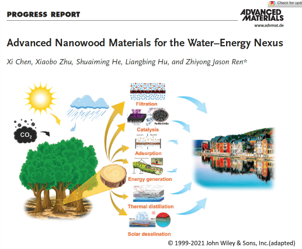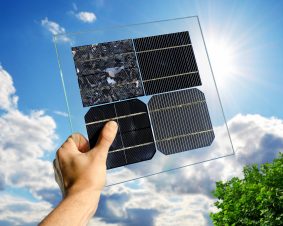 >
Spotlight September 2021: Wood, the raw material of the future?
>
Spotlight September 2021: Wood, the raw material of the future?
One of the greatest challenges facing humanity is to produce clean drinking water under the given circumstances of global warming, population growth and increasing littering. In September, we would like to present a review article that believes one approach to solve this problem is the use of nanoscale wood. In the review, “Advanced Nanowood Materials for the Water-Energy Nexus,” published in the journal Advanced Materials, methods for using wood for water treatment are outlined based on the structure of wood, bottom up or top down. Using the approaches described, wood can be used for water purification, desalination, or chemical removal.
Many examples are shown of how the basic building block of wood, cellulose (a natural polymer), can be processed into nanofibers or polymer matrices, enabling filtration of ultra-small particles.
In contrast, top-down approaches preserve the fundamental structure of wood. For example, naturally occurring channels and mesopores open up the possibility of binding chemicals or applying catalysts. Research with palladium, titanium dioxide, or iron oxide nanoparticles applied to wood showed very good separation of chemicals from water. By chemically modified wood, it was possible to selectively remove copper ions, separate oils and organic solvents, or filter out heavy metals from water.
Wood is an indispensable, climate-neutral raw material due to its ability to bind CO2. In combination with nanoparticles, it may be possible in the future to extend the versatile properties of wood and thus provide a solution approach to water scarcity and environmental pollution.
Original publication:
Chen, X. et al (2021) Advanced Nanowood Materials for the Water–Energy Nexus. Advanced Materials, 33(28), 2001240. doi.org/10.1002/adma.202001240

Weitere Spotlights
Spotlight March 2023: How can photovoltaics be made safe and sustainable?
Conventional photovoltaic systems often have only low efficiency, i.e. only a fraction of the solar energy is converted into electrical energy and made usable. For this reason, research is being conducted into innovative materials that can significantly increase the energy yield and thus also enable more electrical energy to be generated from renewable sources. However, […]
Read moreSpotlight August 2021: Towards FAIR nanosafety data
In August we would like to present a paper on FAIR data. The paper published in Nature Nanotechnology in June 2021 summarises the challenges and provides recommendations for the efficient reuse of nanosafety data in line with the recently established FAIR guiding principles: findable, accessible, interoperable and reusable. This article summarises the know-how on the […]
Read moreSpotlight November 2021: Safe Materials from Scratch – Safe-by-Design in Materials Research
Advances in the field of materials science continue to amaze us with nanoscale materials with extraordinary chemical, electrical, optical, and numerous other properties. However, some nanoscale materials have different toxicological profiles compared to the same bulk material. Since safety issues are usually addressed just before launching a product into the market, safety issues may be […]
Read moreSpotlight November 2022: Photonics in nature and bioinspired designs
Science has always taken nature as a model and imitated it. If you look at the field of photonics, i.e. the use of optical technologies for information processing, transmission or storage, the colorful examples in the animal and plant world are perfect basic drawers for technical applications. While colors in nature are used either for […]
Read more

